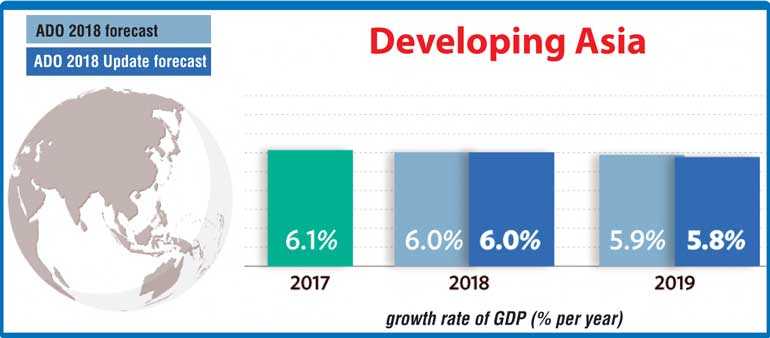Friday Feb 14, 2025
Friday Feb 14, 2025
Wednesday, 3 October 2018 00:00 - - {{hitsCtrl.values.hits}}

Asian Development Bank (ADB) has downgraded its growth forecast for Sri Lanka in 2018 and on weak domestic demand, investment and exports.
In an update to the Asian Development Outlook (ADO) report, ADB downgraded the GDP growth forecast from 4.2% to 3.8% in 2018, after the country recorded a growth rate of 3.1% in 2017, as the Government implements structural reforms supported by the International Monetary Fund (IMF) to lift fiscal performance towards sustaining higher growth.
ADB downgraded the 2019 growth rate from 4.8% to 4.5%, falling below the growth estimate for the sub-region.
“With external demand coming off a high base in the second half of 2017, and little change expected in investment and Government expenditure, projections for growth in 2018 and 2019 are marked down from ADO 2018. A downside risk stems from the approaching elections,” the report notes.
However, South Asia is expected to retain its growth momentum at 7% for 2018 and 7.2% for 2019 as published in April.
The ADO update notes that the bad weather and policy tightening held GDP growth to 3.3% in 2017, while the Government kicked off wide-ranging structural reforms supported by the IMF. The report update records that the country’s fiscal performance improved with tax revenue rising as a share of GDP and a small primary surplus in 2017, stressing on the need for continued structural reforms as heavy debt repayment looms closer.
The country’s GDP growth stayed subdued in the first quarter of 2018 at 3.5% year-on-year, ADB notes as the Agriculture sector, which was hit badly in 2017, recovered with better weather to grow by 5.3% as rice production increased by 53.3%, while the Services sector advanced by 4.8%. However, the industry displayed much slower growth, recording an expansion of only 1.1%, held back by a 4.7% decline in Construction and only modest growth in Manufacturing, the ADB report noted.
Further, the first quarter saw private consumption revive, continued tightening in Government consumption spending, stagnant fixed investment, and lower net exports.
Headline inflation, which recorded a drop of 1.6% year-on-year in April as the Agriculture sector recovered, rose to 3.4% in July owing to higher food prices, currency depreciation, rising global oil prices, and the introduction of the fuel price formula in May, the ADO update noted.
“These pressures and the scheduled introduction of automatic pricing for electricity later this year will see inflation trend higher to average 4.5% in 2018, which is below the ADO 2018 forecast,” the report said.
However, with lower estimated growth in 2019, the inflation forecast, too, was lowered from the forecasted 5.2% to 4.5% in 2018 and from 5.0% to 4.7% in 2019. Further, ADO notes that weakening inflation and growth has led the Central Bank to ease monetary policy in April by lowering the standing lending facility rate by 25 basis points.
While the country’s exports grew by 6.2% in the first half of 2018, as expected, with garments and textiles growing by 5.7%, imports expanded by 12.7%, overshooting forecasts, driven by higher fuel prices, gold for jewellery, and personal vehicles.
ADO notes that the 0.6% decline in imports of investment goods underscores the lacklustre investment environment.
Sri Lanka’s trade deficit widened by 20.2% during the year under review, despite earnings from Tourism and remittances, the main offsets to trade deficits, increasing by 5.8%. ADO also projects the deficit to increase during this year and next year, owing to higher oil prices, high dependence on imports, and only a marginal recovery in remittances.
Discover Kapruka, the leading online shopping platform in Sri Lanka, where you can conveniently send Gifts and Flowers to your loved ones for any event including Valentine ’s Day. Explore a wide range of popular Shopping Categories on Kapruka, including Toys, Groceries, Electronics, Birthday Cakes, Fruits, Chocolates, Flower Bouquets, Clothing, Watches, Lingerie, Gift Sets and Jewellery. Also if you’re interested in selling with Kapruka, Partner Central by Kapruka is the best solution to start with. Moreover, through Kapruka Global Shop, you can also enjoy the convenience of purchasing products from renowned platforms like Amazon and eBay and have them delivered to Sri Lanka.
Discover Kapruka, the leading online shopping platform in Sri Lanka, where you can conveniently send Gifts and Flowers to your loved ones for any event including Valentine ’s Day. Explore a wide range of popular Shopping Categories on Kapruka, including Toys, Groceries, Electronics, Birthday Cakes, Fruits, Chocolates, Flower Bouquets, Clothing, Watches, Lingerie, Gift Sets and Jewellery. Also if you’re interested in selling with Kapruka, Partner Central by Kapruka is the best solution to start with. Moreover, through Kapruka Global Shop, you can also enjoy the convenience of purchasing products from renowned platforms like Amazon and eBay and have them delivered to Sri Lanka.